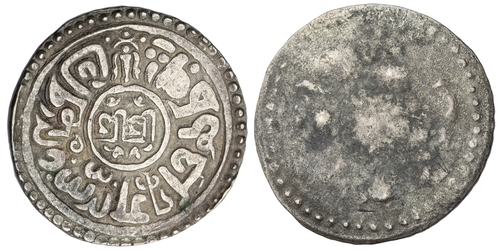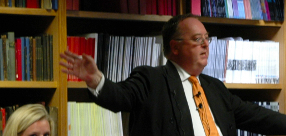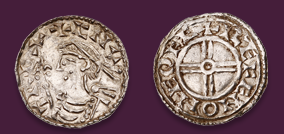
Auction: 25088 - The Nicholas Rhodes Collection of Nepalese Coins Part I
Lot: 31
Nepal, anonymous, Tanka, undated, 'Ala-ud-Din' Type, Obv. legend Śrī Śrī in central circle, Arabic legend around, 'Abu Al-Muzafar Muham Shah 'Ala al-dunya wa-al-din as-sultan, mace with garland and moon and crescent on top of garland, letter to the right of mace consists of a short vertical stroke, two dots and a short horizontal line on top. Small conch with dot outside of square at 8 o’clock, Rev. crouching lion facing right on top of elephant facing right, within two interlaced squares. Arabic legend around reads Sikander althani imin al-Khalifat, 10.30g (RGV 191), good fine / reverse worn flat, apart from to edge, as described in footnote
Provenance
The Nicholas Rhodes Collection of Nepalese Coins and Medals: Part One
Bhupendra Narayan Shrestha, by private treaty, May 1968
Regarding the fact that the reverses of many of the early Nepalese tangkas are worn flat Carlo Valdettaro has suggested two explanations:
1. According to Sri Ganesh Bahur Karmacharya of Bhatgaon such coins were struck on stone anvils and the lower face did not benefit from the action of a sharply cut die. This is a possibility and a similar technique may have been opted also for some of the worst Bengali coins we know from countermarked specimens, BUT it does not appear to solve completely the problem as:
there are similar “Sri Sri” coins with quite good and neat reverses; it is not at all clear how and why the obv. dies (metallic?) should have been in such good conditions and have worked so well, and the rev. dies should have been so poor and worked so ineffectively.
2. Since the earliest Buddhist times it has been considered a pious gesture to pave the floor of temples with coins. A sculpture on the railing of Bharhut Stupa (IMC) represents the scene of the banker Anāthapi??ika purchasing the Jetavana Park in Shrāvastī by covering it with “crores of (punch-marked) coins” (See N.G. Majumdar: A Guide to the Sculptures in the Indian Museum, Part I, p. 46). Though I have never seen it myself, I am assured by Prof. A.N.Lahiri that many temples in India have coins embedded in their floors. We do know for certain that Chandra Shamsher Jung Bahur Rana (ruled A.D. 1901-1929) paved ‘Pashupatinath’ with imitation-coins struck for this particular purpose (that are still at site). We also know that coins 2 to 8 in Landon’s Appendix [Landon, Perceval: Nepal, London 1928, 2 volumes.] came from Pashupati’s treasure rooms, so – putting clues together – could it not be possible that some of our worn “Sri Sri” coins may have been initially used to pave Pashupatinath and have been removed and replaced after millions of pious feet had trodden on them?
The main objection I have heard to this hypothesis lies in the fact that the obverses are generally in good condition and do not show traces of corrosion or accretions; but it may be replied that such coins appear (I cannot say if in all, but surely in many cases) to have been thoroughly and energetically cleaned in recent times.
Carlo Valdettaro: Selection of coins from the collection of B.N.Shrestha, no. 2, Calcutta, 1968 (manuscript).
In a letter of the 1980s to Nicholas Rhodes, Carlo Valdettaro reports a third explanation for the obliterated reverses of some of the early Nepalese tangkas: Some shop owners inserted a coin at one side of a wooden box which they kept on the right side of their seat and which served to keep money and valuables. Whenever they successfully concluded a transaction they rubbed the inserted coin with the fingers of their right hand. Some of these boxes may have served several generations and the exposed side of the inserted coins may have become completely effaced with time.
This “hypothesis” may be less objectionable than the first two taking into account that most of the early tangka coins were melted down after about 1650 after the new Mohar standard had been introduced. Most coins which were used by shop owners as described above may have escaped the melting pot and this may explain why a considerable number of surviving tangkas have partly or completely obliterated reverses, having been kept as a kind of good luck charm in the families of shop owners a long time after the early tangkas had been demonetized.
The cataloguer would like to add that a considerable number of the early tangkas have survived in Tibet and most of those which the cataloguer has seen had reverses in better condition than the reverses of the specimens which have survived in Nepal.
Subject to 20% VAT on Buyer’s Premium. For more information please view Terms and Conditions for Buyers.
Estimate
Starting price
£280




